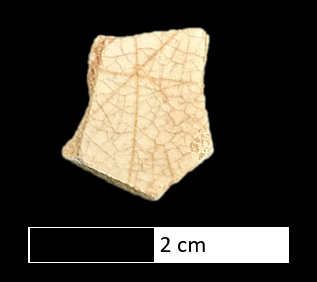By Heather Hembrey, M.A., M.A.A.
 To most eyes, this small sherd of creamware looks like thousands of other creamware sherds found on Fairfax County archaeological sites. Creamware was produced in England from ca. 1740 to 1830. Because it was mass-produced and inexpensive, creamware tableware, tea sets, and other vessel types were exported to the American colonies and widely available to the middle class. Over time, these pieces were broken, tossed and left for archaeologists to recover and interpret.
To most eyes, this small sherd of creamware looks like thousands of other creamware sherds found on Fairfax County archaeological sites. Creamware was produced in England from ca. 1740 to 1830. Because it was mass-produced and inexpensive, creamware tableware, tea sets, and other vessel types were exported to the American colonies and widely available to the middle class. Over time, these pieces were broken, tossed and left for archaeologists to recover and interpret.
But there is something unique about this little creamware sherd. A close look reveals that an asterisk/star symbol was cut into its glazed surface. The most significant aspect of this incised sherd is that it was recovered at a site in Fairfax County where enslaved African Americans once lived and worked. Nearby, archaeologists also found a carved soapstone effigy with African-style decorations, a bead, quartz fragments and Colonoware – a pottery often recovered at sites once occupied by enslaved people.
We don’t know the names of the enslaved people who lived at the site or which African faiths and spiritual traditions they practiced, but the sherd with the incised asterisk/star symbol and other artifacts are associated with religious beliefs and rituals that Africans from many regions carried with them to America. Although belief systems varied widely in the areas from which these people were taken and eventually enslaved, some elements such as symbolism were sometimes similar. Enslaved people used altered every-day objects in traditional African magic and conjuring practices that they hid from their Christian masters. Quartz, a carved figure, a bead, and ceramic decorated with an asterisk/star found at this Fairfax County site are evidence that the enslaved occupants participated in faith rituals, perhaps to retain a connection to their homeland and ease slavery’s spiritual and emotional burden.


